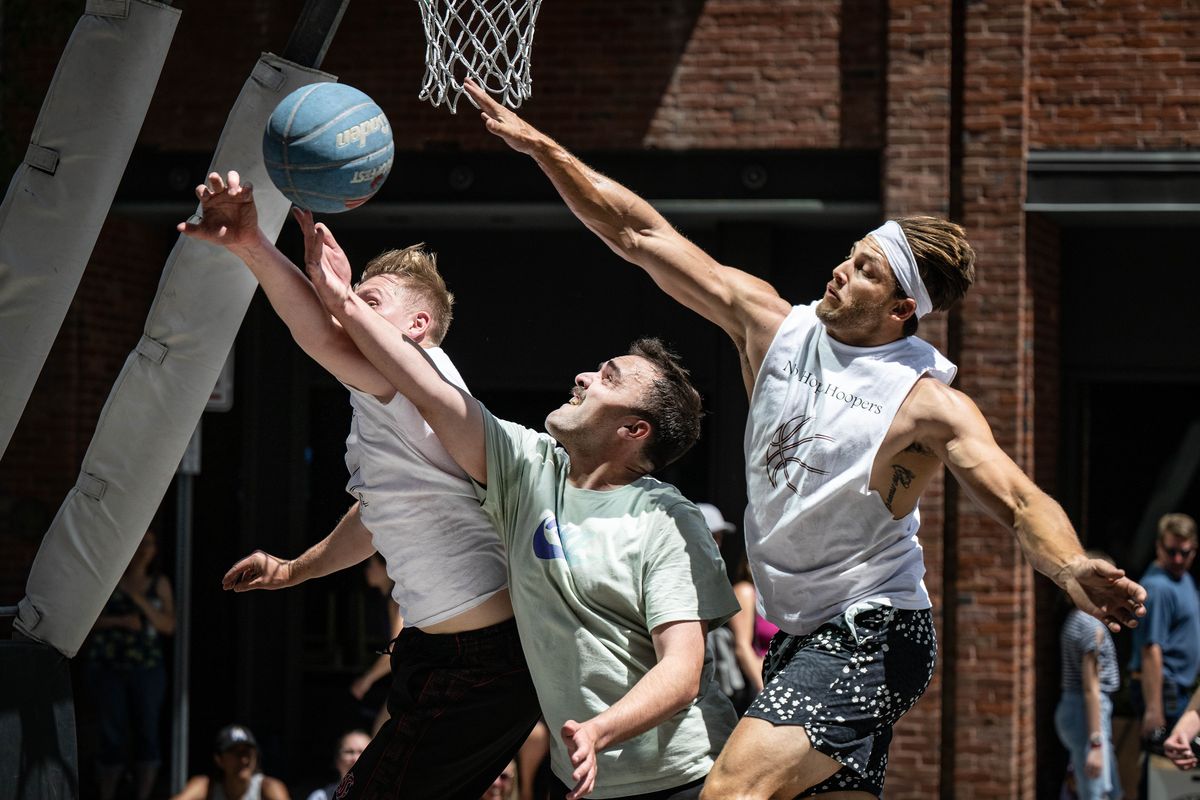Another Hoopfest, Bloomsday and Ironman are over. Are the Inland Northwest’s signature sports events finally rebounding from the pandemic?

With another Hoopfest on the books, organizers of the legendary basketball tournament and other major local events said they’re hopeful the Spokane area is getting back on track after the COVID-19 pandemic.
Participation in Hoopfest jumped more than 20% this year – still below Hoopfests previous to the pandemic, but a boost organizers hope to build on.
“Getting back out there, I think people are more comfortable in crowds this year than last,” said Riley Stockton, Hoopfest’s executive director. “I think a lot of people missed Hoopfest and were happy to get back out there.”
From 2017 to 2019, an average of 6,000 teams – 24,000 players –registered for Hoopfest. In 2022, the first year back after the pandemic, 3,500 teams participated. About 4,250 teams and 16,000 players played this year.
Participation numbers in this year’s Bloomsday also hint at a hopeful future for the race.
With racers having the option to participate either virtually or in person, 29,161 participants crossed the finish line this year, 3,279 doing so virtually. This year’s total is up by nearly 3,000 people from last year, when there were 26,364 finishers. Of those, 5,276 competed virtually.
Still, participation in Spokane’s annual 12K hasn’t reached its pre-pandemic potential. There were 6,083 fewer participants this year than in 2019.
Don Kardong, Bloomsday’s founder and a 1976 Olympic runner, is satisfied with this year’s turnout, saying the outlook for future community athletic events “looks really good.”
“The numbers are moving in the right direction, that’s the important thing,” he said.
Kardong was happy with the day’s overall result.
“The weather made it a great day and a beautiful experience,” he said, adding that he is “Looking forward to next year.”
While numbers were up this year for Bloomsday and Hoopfest, participation was down in this year’s Coeur d’Alene Ironman.
There were 1,171 athletes who started the event on Sunday. That’s comparable to 2017, when 1,104 athletes registered for the race.
In 2021, when some other Ironman events across the world were canceled, participation topped 2,100. Last year’s event was only a half-Ironman and also had about 1,000 more participants than this year.
Local businesses feel the effects
For local coffee shops in the downtown area, Hoopfest is one of the busiest weekends of the year, as participants and attendees alike seek the air conditioning, water and shade that only places like Indaba and Atticus can provide.
“I think that we’re a bit of an oasis,” said Bobby Enslow, the owner of Indaba, a coffee shop on Riverside.
Hoopfest this year attracted an estimated 200,000 attendees, including players and onlookers, Stockton said. That’s up from 175,000 last year, but down from estimated highs in the past of around 250,000.
At Atticus, heat-weary crowds waited in lines that trailed across the parking lot over the weekend to purchase bottled water and midday coffees. Despite Hoopfest’s relatively low attendance this summer, Atticus barista Abbie Keeshan estimates that the coffee shop was busier than ever, even in comparison to the years before the pandemic.
Indaba offered water for free, and even stocked up on bags of ice to prepare for the demand. Sales this Hoopfest were double those in 2022, Enslow said, yet he feels that business ran smoother due to their recent remodel and early planning.
To Enslow, events like these are crucial to Spokane, as locally owned businesses continue “climbing out of the hole” that the COVID-19 pandemic put them in. While things may seem better, he said, many small businesses are still struggling to recover. Hoopfest is helping them bounce back.
At The Wet Whistle, a self-described “coffee and cocktail bar,” employee Michael Ann said the lines were going out the doors, with waves of customers coming in when the games settled down.
The Frozen Lemonade Vodka was the most sold item during the event, with coffee and other alcoholic beverages being popular choices too.
Spencer Greer, the general manager of Dry Fly Distilling, said it wasn’t that much different compared to other workdays, though they had special cocktail promotions going on for Hoopfest, including 24 canned cocktails for $90.
At River Park Square, Ben & Jerry’s was bustling with customers, money and ice cream, said Kaylynne Edwards, an employee working Saturday and Sunday. She said sales hit around $3,000 dollars more than usual.
Looking ahead
Following the pandemic, Hoopfest continues to draw participants through advertisements and social media. But the most significant advertisement, according to Stockton, is when participants genuinely enjoy the atmosphere and spread the word about the event.
He thinks Hoopfest can definitely grow, but he said it’s possible that 250,000 may have been above an ideal attendance level. The first Hoopfest in 1990 co mprised just 2,009 players on 512 teams.
“This year was successful, and we will continue to take it year by year,” Stockton said. “We want it to be big, but we also want it to be well run.”
Reporter Paige Van Buren contributed to this article.